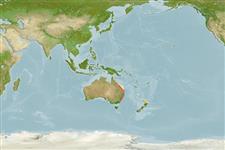Environment: milieu / climate zone / depth range / distribution range
पारिस्थितिकी
समुद्री; खारा ड़िमरसल; गहराई सीमा 0 - 30 m (Ref. 6390). Subtropical; 17°S - 38°S
Western Pacific: endemic to Australia. Present along the east coast between approximately Cairns, Queensland (Ref.27242) and Gippsland lakes in eastern Victoria.
Length at first maturity / आकार / वज़न / Age
Maturity: Lm 50.2 range ? - ? cm
Max length : 120 cm TL पुल्लिंग / अलिंग; (Ref. 27112); अधिकतम प्रकाशित वज़न: 15.0 kg (Ref. 27248)
Short description
पहचान कुंजी | आकृति विज्ञान | मौरफोमैटरिक्स
पृष्ठीय रीढ़ (सम्पूर्ण) : 8 - 9; पृष्ठीय सौफट रेज़ (सम्पूर्ण) : 13 - 14; गुदा कांटा: 0; ऐनल सौफट रेज़: 13 - 14; जानवरों की रीड़ का जोड़: 27.
Generally inhabit shallow bays and inlets and can be found in estuaries as far as tidal limits (Ref. 27246); they often invade freshwater. They occur over mud, silt gravel, sand and seagrass (mainly Zostera species) beds from intertidal areas to depths of 10 m in Queensland and to 30 m in southern New South Wales. Eggs and larvae are dispersed along the coast by tidal and current movements (Ref. 27112). Small juveniles less than 12 cm TL first appear in coastal bays 1-2 months after spawning. They mainly inhabit shallow mangrove and mud flats and seagrass beds (Ref. 27246, 27245). They are usually solitary but may form loose aggregations (Ref. 2165, 27247). Feed on small fish, crabs, prawns, small crustaceans. octopus, squid and polychaete worms. They have spines on the outer edges of their head which can inflict nasty cuts during handling (pers. comm., Bernard Moss, 2001).
There is conflicting information (Ref. 27246, 27245, 27247) on whether dusky flahead are protandrous sex reversers or not.
Paxton, J.R., D.F. Hoese, G.R. Allen and J.E. Hanley, 1989. Pisces. Petromyzontidae to Carangidae. Zoological Catalogue of Australia, Vol. 7. Australian Government Publishing Service, Canberra, 665 p. (Ref. 7300)
IUCN Red List Status (Ref. 130435: Version 2024-1)
Threat to humans
Harmless
Human uses
मात्स्यिकी: व्यापारिक; आखेट मत्स्य: हां
साधन
Special reports
Download XML
इंटरनेट स्रोत
Estimates based on models
Preferred temperature (Ref.
123201): 19.1 - 27.1, mean 25.2 °C (based on 291 cells).
Phylogenetic diversity index (Ref.
82804): PD
50 = 0.5000 [Uniqueness, from 0.5 = low to 2.0 = high].
Bayesian length-weight: a=0.00457 (0.00230 - 0.00908), b=3.09 (2.91 - 3.27), in cm total length, based on LWR estimates for this (Sub)family-body shape (Ref.
93245).
Trophic level (Ref.
69278): 4.1 ±0.52 se; based on food items.
लौटाव (Ref.
120179): माध्यम, न्यूनतम जनसंख्या दुगनी होने का समय 1.4 - 4.4 वर्ष। (K=0.22; tm=2).
Fishing Vulnerability (Ref.
59153): High to very high vulnerability (72 of 100).
Nutrients (Ref.
124155): Calcium = 132 [8, 523] mg/100g; Iron = 2.27 [0.58, 6.12] mg/100g; Protein = 19.2 [16.9, 21.6] %; Omega3 = 0.481 [0.216, 1.350] g/100g; Selenium = 54.4 [13.6, 213.1] μg/100g; VitaminA = 4.35 [1.42, 12.68] μg/100g; Zinc = 0.72 [0.34, 1.57] mg/100g (wet weight);
